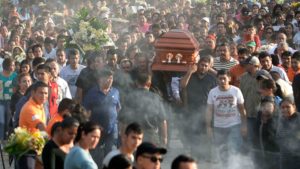Special to WorldTribune.com
By Allan Wall, MexiData.info
The analysis of Mexican murder statistics is a grisly business because these statistics are not just numbers, but represent real people who were homicide victims.

According to the Mexican government’s own statistics, the Mexican murder total in 2016 was 20,792, the highest it’s been since 2012. (Enrique Peña Nieto became President of Mexico on December 1, 2012.)
The 2016 murder total of 20,792 was an increase over that of 2015, which was 17,013, which in turn was a nearly 9% increase over the previous year of 2014, with a murder total of 15,653 reported.
Not only that, but the stats show that even during 2016 the murder total was rising, reaching its peak in August and September with monthly murder totals just below 2,000 in each of those two months.
Tristan Clavel, at the InSight Crime website, interprets the increase thusly: “The trend of rising homicides is a strong indication of the deteriorating security situation in Mexico. Given the recurrent evidence of organized crime’s substantial responsibility for insecurity in violent areas, as well as recent reports arguing that criminal structures are responsible for over half of murders in Mexico, the latest trends represented in the official data are likely the result of ongoing shifts in the underworld.”
By “ongoing shifts in the underworld,” Clavel is referring to conflicts among criminal organizations which can be influenced by law enforcement actions. Even successful operations carried out by Mexican security agencies can have unforeseen consequences.
For example, if you take out the head of a drug cartel who is going to step up to fill the vacuum? There may be a bloody power struggle.
Or, if one drug cartel is weakened, how will rival drug cartels react?
In Clavel’s view, “the [Mexican] government’s policy of taking down heads of criminal organizations can stimulate internal fighting within a cartel, which in turn often has a direct impact on public security in concerned areas. Over time, successful government action against a specific cartel can also impact the power balance between rival groups, leading to increases in violence as up-and-coming organizations challenge traditional power brokers for control.”
Another troubling trend is the ongoing murder of journalists in Mexico. As Elena Toledo of Pan Am Post reports, “Since the year 2000, 96 journalists have been murdered in Mexico.”
She also reported that “In November 2016, the organization Artículo 19 published a report stating that in 2016 alone more journalists were murdered than during the rest of President Enrique Peña Nieto’s six-year term.”
The latest such murder was the March 2, 2017 homicide of Cecilio Pineda, murdered in the violent state of Guerrero. The reporter was shot by “armed men on a motorcycle,” which indicates it was not a random shooting.
Also, the murdered reporter had been previously threatened by criminal gangs, and he had actually been attacked (but escaped unscathed) in September of 2015. [Source: Violence in Guerrero, Mexico Claims Yet Another Journalist’s Life, Elena Toledo, Pan Am Post, March 3rd, 2017.]
Hopefully these negative trends will decrease in 2017.
